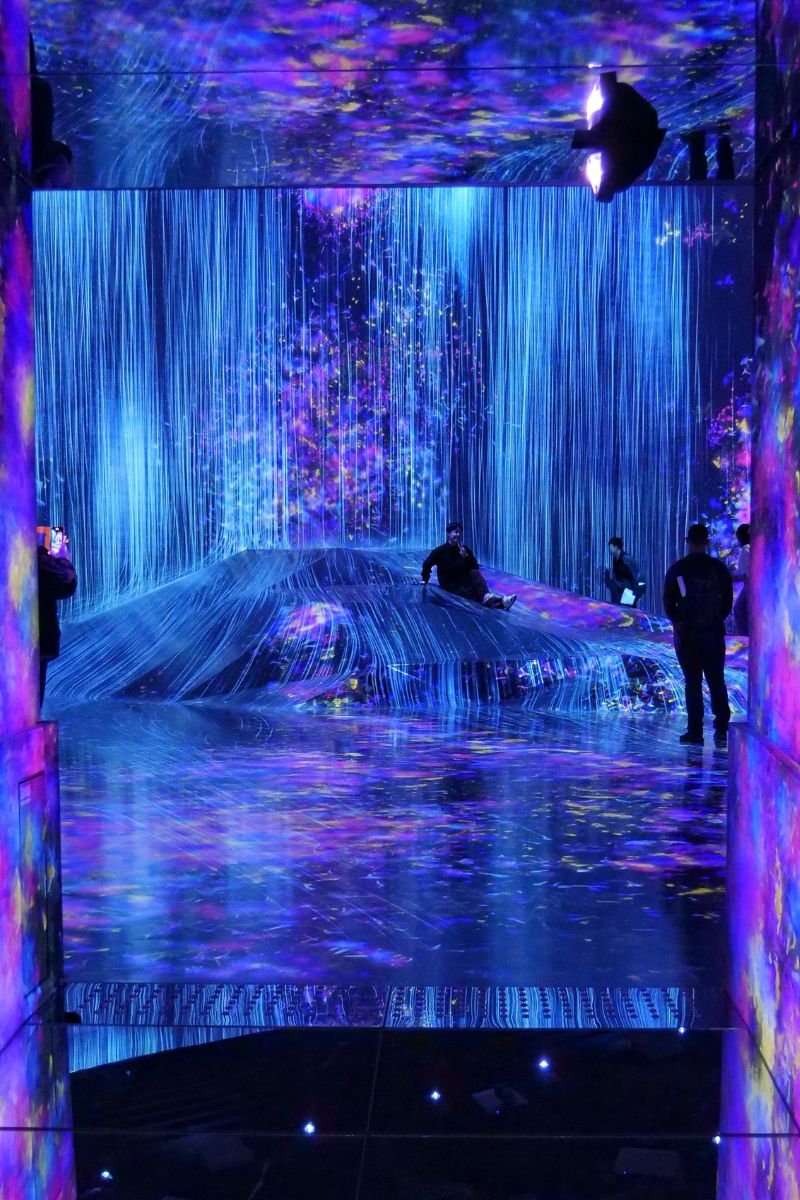Have you ever imagined entering a space where art and technology merge with human interaction? TeamLab Borderless Tokyo encourages visitors to ‘wander, explore and discover’ unique multi-sensory digital art exhibits.
Is this whole concept pretentious? Or has TeamLab created a must-visit attraction that deserves its Guinness World Record title?
Walking up to the museum entrance, I saw a large, distorted TeamLab Borderless logo covering the ceiling and walls. When I took out my camera to snap a photo, the logo appeared to line up and look completely straight. This is when I realised I was about to witness a mind-blowing experience.
In this article, I will explore what makes TeamLab Borderless one of Tokyo’s most visited tourist attractions. I will cover the good and the bad, explain how to buy tickets, discuss how to get there, and offer some tips and advice for visitors. Then, I’ll finish with my opinion on whether this attraction lives up to the hype.
Disclaimer: This article contains affiliate links. If you book after clicking on one of these links then we may receive a small commission at no extra cost to you.
- Discover the reborn TeamLab Borderless, now in Azubadai Hills. Guinness World Record Holder for the most visited museum (single art group).
- Explore a world of immersive digital art.
- Book through Klook or directly through Borderless.
- Also, check out the Klook Greater Tokyo Pass for discounts and more morning timeslots.
What is TeamLab Borderless Tokyo?
TeamLab Borderless Tokyo is not only one of the most visited attractions in Tokyo but also a Guinness World Record holder. In 2019, it welcomed over 2 million visitors, making it the most visited museum dedicated to a single art group or artist in a year. TeamLab Borderless uses over 400 projectors to create an interactive digital art museum.
Brief History of TeamLab Borderless Tokyo
TeamLabs Borderless first opened in Odaiba on June 21, 2018. It became one of the top attractions in Tokyo and began breaking world records. In 2022, TeamLabs made a shock announcement that TeamLab Borderless Tokyo was set to close on August 31. They were going to open a new permanent location in the Tokyo City Centre sometime in 2023.
The highly anticipated Azubudai Hills complex opened on November 24, 2023, and would become the new home of TeamLab Borderless. After some delays, the ever-popular digital art gallery opened its world-bending doors once again on February 9, 2024.
Overview of TeamLab Borderless
There is no linear route to follow at TeamLab Borderless Tokyo. It’s a 10,000-metre space (32808 ft) with an almost maze-like layout. You are encouraged to ‘wander, explore and discover’ the exhibits without any guides or maps.
TeamLab Borderless features free-flowing and ever-changing interactive art. These designs move across the walls from room to room, so if you visit an exhibit for a second time, it could look completely different from the first time.
Before arriving, TeamLab suggests you download the official TeamLab app to your phone. This app allows you to interact with some of the exhibits. Depending on your choices, the art and lights will react in various ways, affecting the lighting’s colour, speed, and patterns.
The app also explains the concept behind each exhibit to improve your understanding of the piece.
There are many popular exhibits at TeamLab Borderless Tokyo. Some of the most notable include:
- Universe of Water Particles on a Rock where People Gather is a large space with a projection waterfall pouring onto a rock hill that visitors can walk up.
- Infinite Crystal World uses crystal lights and mirrors to create an illusion of infinity.
- Bubble Universe is a mirrored room filled with various bubble spheres with ever-changing light styles and colours.
- Microcosmoses: Wobbling Light has countless wobbling lights that travel through a space that expands infinitely, resembling a universe of lights and spheres.
- Sketch Ocean is a projection of a bright aquarium with fish hand-drawn by visitors.
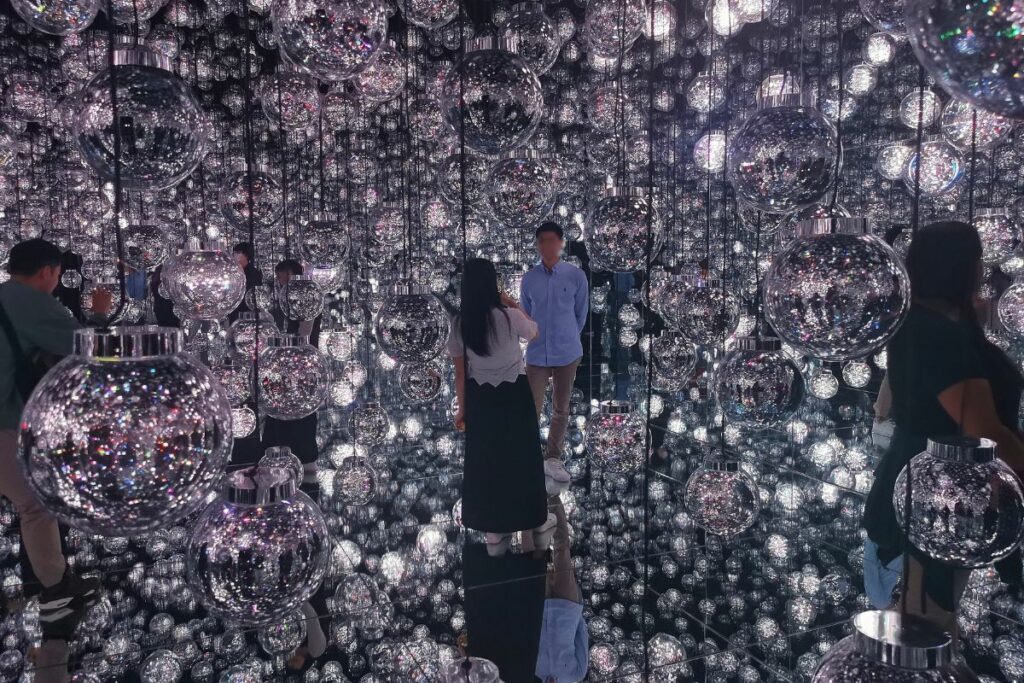
Why visit TeamLab Borderless?
TeamLab Borderless Tokyo offers visitors to Japan the chance to visit an art museum unlike anything they have ever seen before. There are only a few opportunities worldwide to experience this kind of attraction.
The uniqueness of the experience is why it is one of the most popular attractions for tourists in Japan. People who will enjoy TeamLab Borderless the most include:
- Technology Enthusiasts: See some of the most technological interactive projections in the world.
- Families with Children: Suitable and engaging for all ages, with a few very popular exhibits with kids.
- Photography and Social Media Fans: A variety of different themed rooms with lighting to create stunning backdrops and photo opportunities.
- Fans of Immersive and Interactive Experiences: Get lost in an immersive digital art gallery as you explore and interact with the exhibits.
- Modern and Digital Art Lovers: A variety of modern-meets-digital art on display in a borderless world.
- General Tourists and Travellers: This is a popular spot for tourists, as it offers something different from Tokyo’s famous temples, shrines, shopping, and restaurants.
- Explorers of New Experiences: Even if you aren’t a fan of regular museums or art galleries, this is a welcoming experience for everybody.
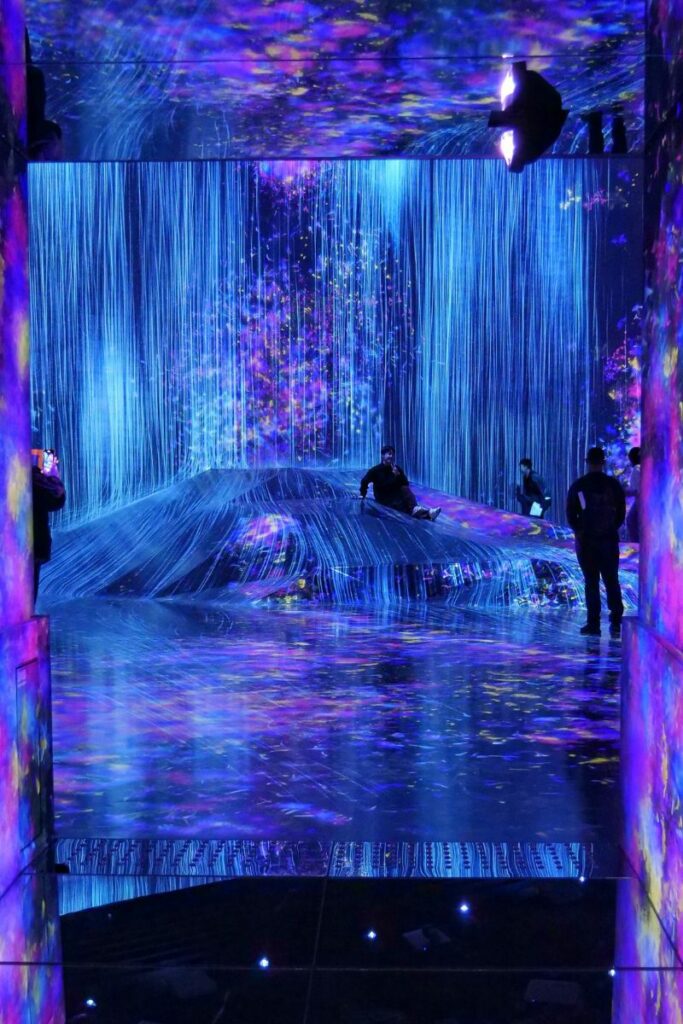
Who Might Find TeamLab Borderless Less Appealing
TeamLab Borderless Tokyo is on many Tokyo itineraries. Critics and visitors rave about the attraction. That being said, some people might want to skip this experience.
- Traditional Art Enthusiasts: Lovers of traditional and classic art might find the digital projections a turn-off. They also might not see the appeal in the interactive aspect.
- Lovers of traditional Japanese history and culture: Although TeamLabs Borderless was created by Japanese artists and features some Japanese elements, it doesn’t always feel culturally Japanese.
- Visitors with light or sound sensitivity: Borderless has some rooms with bright lights, projections, darkness, and even some strobe lighting. Each exhibit also has sounds and music, which could overwhelm visitors sensitive to light and sound sensory experiences.
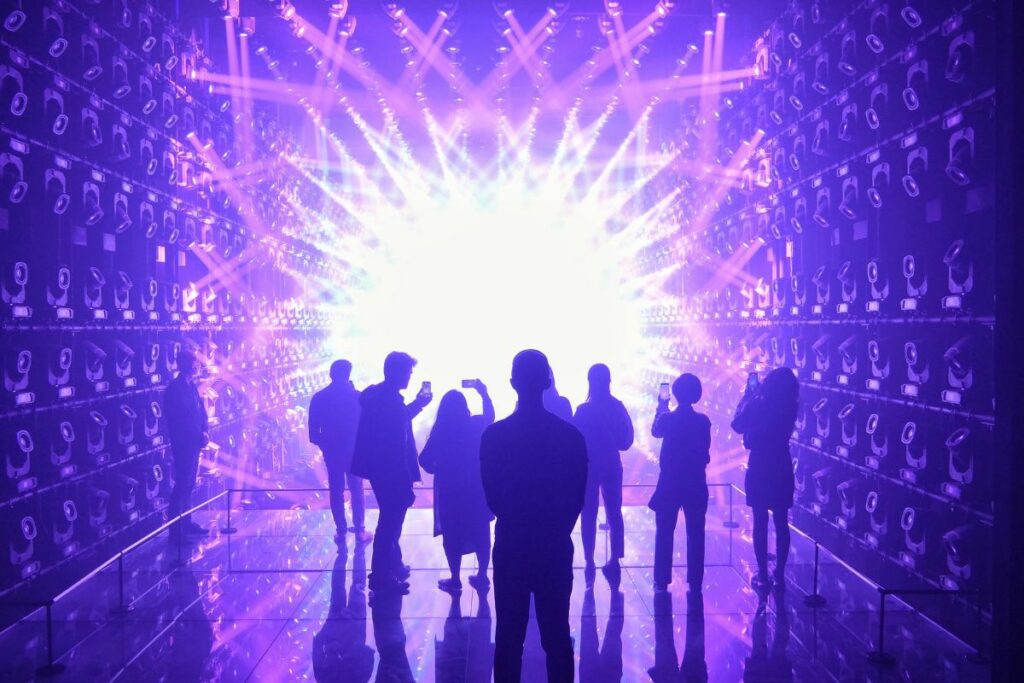
Preparing for your visit to TeamLab Borderless
Before you begin preparing your trip to TeamLab Borderless Tokyo, you may have some questions that need answering, such as when you should go and how to buy tickets.
When to Visit TeamLab Borderless Tokyo
A great selling point of visiting TeamLab Borderless is that it is an all-weather attraction. Being indoors, it’s a great way to escape Tokyo’s summer heat and the perfect way to stay dry during the rainy season. TeamLab Borderless is a great addition all year round to any Tokyo itinerary.
When deciding which day to visit, remember that Tokyo is one of the most populated cities in the world, and millions of tourists descend upon the city every year.
With this in mind, TeamLab Borderless is best visited on weekdays as it can be a little quieter. On weekends and during school holidays, this attraction can become even busier than usual and will often sell out even quicker. Please check in advance to make sure your selected day doesn’t fall on a Japanese public holiday.
Consider arriving early for the opening 10 am slot to beat the crowds. Borderless also quietens towards the closing, so from 8 pm onwards, you should have more space to move and explore.
My time for TeamLab Borderless Tokyo was 6:30 pm. When I first arrived, it was busy, with most of the rooms being crowded, but I only had to wait around 2 minutes to enter one of the most popular rooms. By the time it hit 8 pm, it started to die down. Some rooms that had been filled with people were now almost empty. This gave me a better chance to wander and soak in all the immersive art.
How to Buy TeamLab Borderless Tickets
There are a few different methods for purchasing tickets. These include the official website, same-day tickets at the venue, or ordering through Klook.
TeamLab Borderless Ticket Options
You need to be aware of a few different options and prices for standard entry tickets for TeamLab Borderless Tokyo.
- Visitors aged 13-17 require a youth ticket.
- Children aged 4-12 will require a child ticket.
- Entry is free for children three and under when with a paying adult.
- For visitors with disabilities, there is a discount ticket price.
Klook also sells a Greater Tokyo Pass which allows you to buy one pass and select multiple attractions (between 2 and 8) and receive a discount. If you choose Borderless TeamLab as one of the attractions, you can select a Klook exclusive early-bird ticket for morning timeslots.
Where to Buy
Tickets can be purchased up to 3 months in advance on the official TeamLab Borderless website. You can buy tickets online via credit card or PayPay or on the day at the venue entrance. I recommend buying tickets in advance, as Borderless can sell out.
Another way to buy a TeamLab Borderless ticket in advance is through the ticket agent Klook. They make the process of purchasing tickets very simple.
Your ticket will be emailed to you as a QR code. When you arrive at the entrance, the staff will check your timeslot on your ticket. Then, you will scan the QR code at the ticket gate to enter.
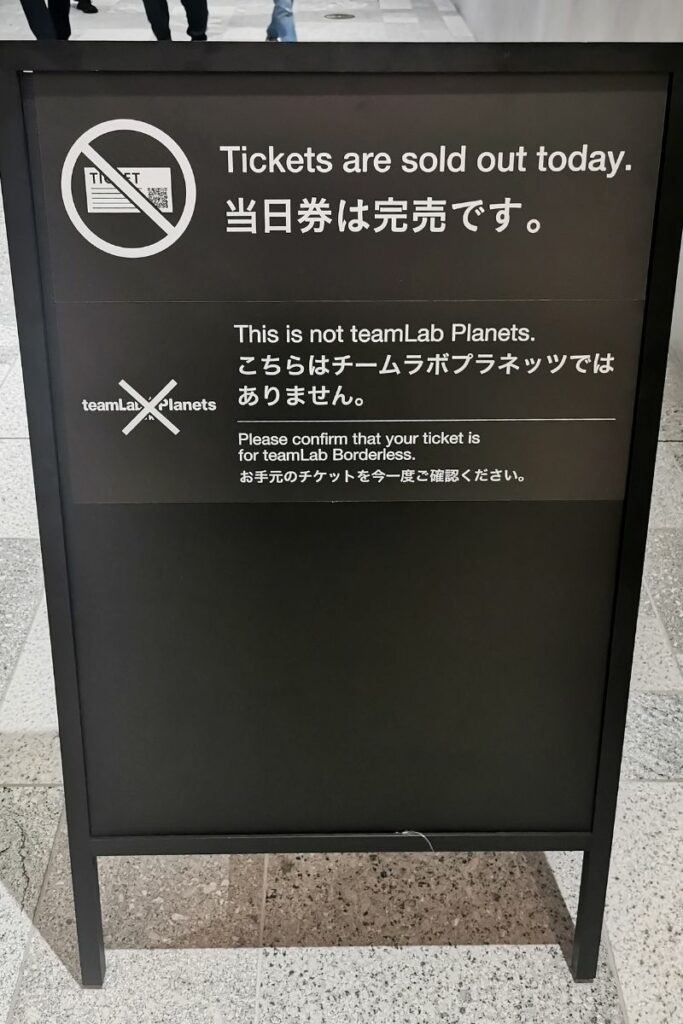
TeamLab Borderless Ticket Prices
Adult tickets will be cheaper if you buy them further in advance. They are also more expensive on weekends and holidays.
- Adult (18+) – Prices vary between 4,000 yen and 4,600 yen
- Youth (13-17) – 2,800 yen
- Child (4-12) – 1,500 yen
- Child (3 and under) = Free
- Disability Discount = 2,000 yen
Tickets are the same price on the official website and Klook.
What to wear to TeamLab Borderless
TeamLab Borderless doesn’t require you to go barefoot like TeamLab Planets does. There is no water to walk through, so you don’t have to wear shorts, and you can wear whichever shoes you want.
Some rooms have mirrored floors and ceilings, so other visitors could see up your skirt. Japanese visitors tend to wear shorts under their skirts or dresses when they visit.
Plain clothes will make you stand out more in photos. Black clothing will make a great contrast with the colourful backgrounds. At the same time, white clothing will make you stand out more and set you apart from the backdrop. Try not to wear patterned clothes if you want striking photographs.
TeamLab Borderless Tokyo Hours of Operation
TeamLab Borderless is open seven days a week, with hours sometimes changing by season. They also close on some national holidays or special events each month. It is worth checking this in advance.
The last entry is one hour before the museum closing time.
En Tea House opens 30 minutes after the museum’s opening time.
For the most up-to-date information on hours of operation, check the Borderless website (under the ‘Visit Us’ section).
April to June Opening Times and Closures
- April and May Opening times: 10:00 am – 9:00 pm
- June opening times: 9:00 am – 9:00 pm
There are early closures on April 16, May 14, May 28, June 11 and June 25.
TeamLab Borderless will be closed on April 17, April 18, April 23, May 7, May 21, June 4 and June 18.

Getting to TeamLab BorderlessTokyo
TeamLab Borderless is now located in central Tokyo, in the new Azabudai Hills complex. This is a plaza in the middle of a modern urban village surrounded by skyscrapers.
Azabudai is a district of Minato, Tokyo, situated next to the popular entertainment district of Roppongi.
TeamLab Borderless Address: Azabudai Hills Garden Plaza B B1, 1-2-4 Azabudai, Minato-ku, Tokyo
Access by Public Transport
The quickest and easiest way to get to TeamLab Borderless Tokyo is by train. There are a few different options you can select when travelling there.
- Kamiyacho Station has a direct connection to Azabudai Hills from Exit 5. Kamiyacho Station is on the Tokyo Metro Hibiya Line.
- From Shinjuku Station, take the Yamanote Line to Ebisu Station (9 minutes). Then switch to the Hibiya Line to Kamiyacho Station (9 minutes).
- From Roppongi-Itchome Station, TeamLab Borderless is a 4-minute walk from Exit 2. Roppongi-Itchome Station is on the Tokyo Metro Namboku Line.
- From Shinjuku Station, take the Chou Line to Yotsuya Station (3 minutes). Then switch to the Namboku Line to Roppongi-Itchome Station (6 minutes).
If you prefer to travel by bus, there are a few options from Shibuya Station. The bus will stop right by the entrance of Azabudai Hills. Look for:
- the Shibuya Route 88 bus for Azabudai Hills,
- the Shibuya Route 86 bus for Toranomon 5-chome,
- the Shibuya Route 95 bus for Toranomon 5-chome, and
- the Shibuya Route 96 bus for Iikura Katamachi.
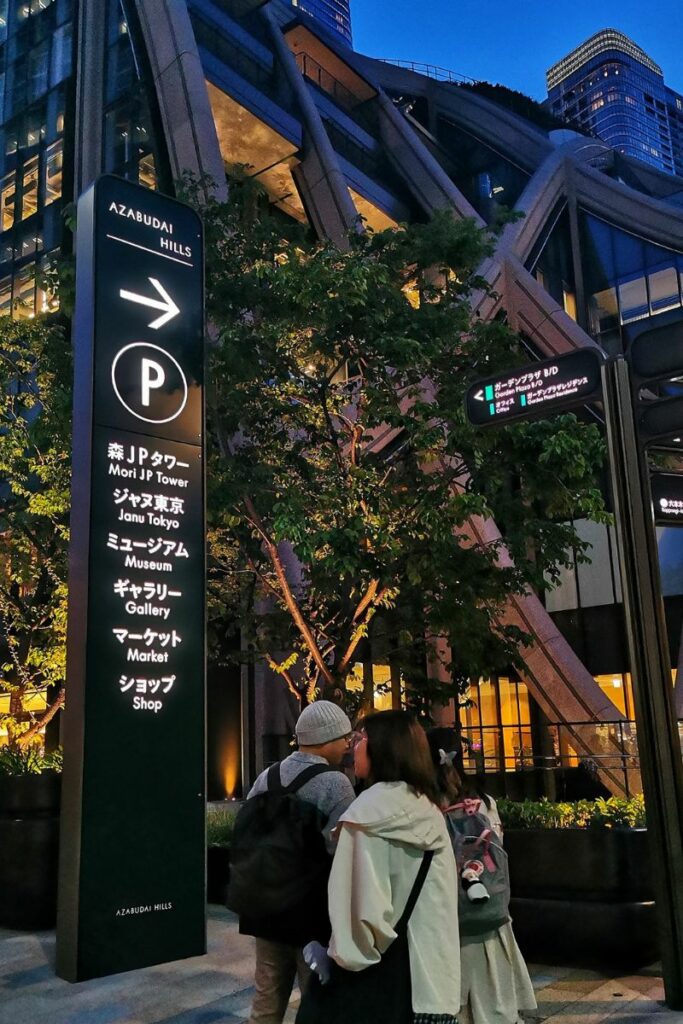
The TeamLab Borderless Experience
If this is your first time visiting a TeamLab exhibition, you might be left in awe when you first step foot inside this digital art museum.
I visited TeamLab Planets last year, and even I was caught off guard by how stunning some exhibits are.
Universe of Water Particles on a Rock where People Gather
The Universe of Water Particles is one of the largest spaces and most photographed areas.
I had seen many photos of this exhibit on social media, but they didn’t do justice to the scale of this room.
This room has walls and a floor that is constantly changing. When I first entered, it looked like a room of water. People were walking as the computer-generated water appeared to follow them and make designs based on their movements.
At the back of the room, there is a large rock-shaped object that visitors can walk up to pose for photos. Behind the rock, water flows down the back wall and bounces on it to create a complete digital waterfall.
This exhibit is very interactive. If you lean against the wall, the water changes direction and flows away from you. Birds, fireflies, and Japanese kanji appear on the walls, changing and transforming with the human touch.
When I returned to this exhibit later, it had changed completely. The water was gone, replaced with a bright and colourful forest of flowers that blew around the room as if they were travelling with the wind.
Crystal World
Many visitors like the Crystal World, which resembles the Infinite Crystal Universe exhibit at TeamLab Planets.
This exhibit uses mirrors on the floor, walls, and ceiling, along with thousands of pointillism lights. The mirrors and lights create an optical illusion that the room and crystal lights are infinite. Sometimes, you will catch yourself looking at mirrors without even realising it.
Crystal World is another popular area for Instagrammers and photographers. Find the perfect area and get your pose ready. The lights are always changing, morphing, and flashing, but if you time it right, you can capture photographs with stunning backdrops.
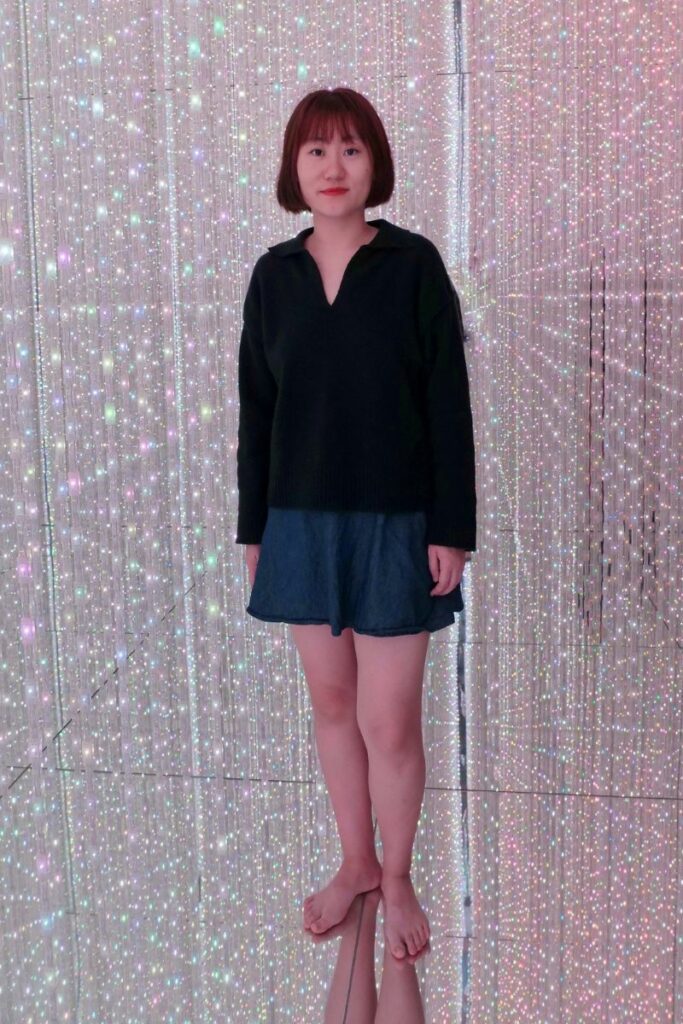
The Bubble Universe
This is an exclusive exhibit for TeamLab Borderless Tokyo and another favourite area for photographs.
Bubble Universe is a timed room, so please remember that before entering. When I entered, the staff told me to stay for only three minutes. A positive aspect of this room being timed is that it limits the number of people inside at once, allowing you to be more creative.
The Bubble Universe is filled with hundreds of bubble spheres hanging from the ceiling. These bubble lights contain different colours and styles of lights, and once again, they are interactive. When you stand near a bubble, it will light up and become brighter, then spread to nearby lights.
While spending my time in The Bubble Universe, the lights changed from white and blue, to a dark yellow and orange colour. This made the entire room look different and gave it a different feeling and atmosphere.
Light Sculpture
One of the exhibits that caught me off guard was the Light Sculpture. Before entering the room, I noticed a large screen outside. It looked like a Spotify playlist, featuring a bunch of different names like The Haze, Awakening, and Sea of Clouds. Each name also had a duration below it.
Walking into this room is like entering a rave. Although this exhibit isn’t interactive, it feels immersive. Rows of people line up, standing at the front of the room, watching a visual show created by moving lights that change colour, and smoke adds to the effect.
Music plays that suit the theme and intensity of the lights. Standing at the back, it looks like a bunch of people enjoying a concert with a spectacular light show.
Microcosmoses: Wobbling Light
One of the new exhibits for TeamLab Borderless Tokyo that wasn’t in its old location is Microcosmoses.
This is another exhibit that features hundreds of ball lights. This time, they travel around the room on tracks. Again, the use of mirrors makes the room look like an infinite space that’s hard to comprehend.
Standing in the middle as the balls of lights move, change colour, and fade on and off, you feel like you are standing in the middle of the universe – a truly impressive sight.
Wobbling Light was created as part of TeamLab’s art project ‘Cognitive Sculpture’. Their aim for this project was to create sculptures that “do not exist in the physical world, but rather in the cognitive world.”
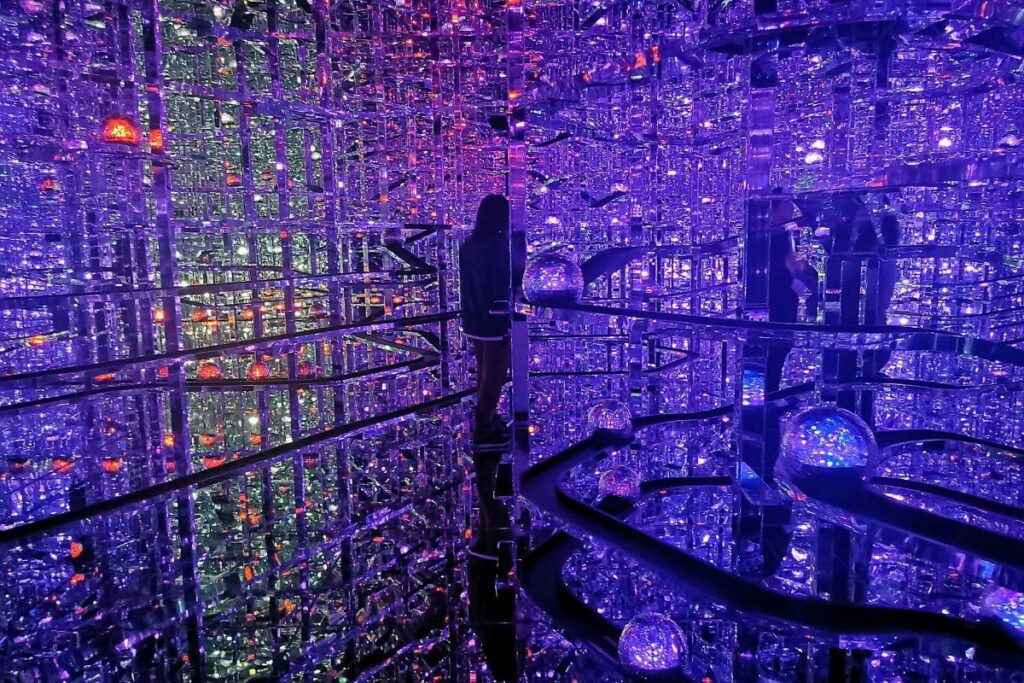
Sketch Ocean
The most interactive exhibit at TeamLab Borderless Tokyo is the Sketch Ocean, and surprisingly, visitors create a lot of this art.
Upon entry to this room, I thought it looked like a large digital aquarium. The walls are covered in floor-to-ceiling digital projections. It all looks blue, like the ocean, and a variety of fish and sharks are swimming around the room. But, once you look closer, you will notice that some of these fish are hand-drawn.
In a separate room at the back of Sketch Ocean, there are chairs and tables for visitors to sit. Here you can draw and colour your own fish on the provided paper and submit it to the staff. It will then appear swimming through the Sketch Ocean with the other fish.
This room is also interactive. If you touch the fish, they will change direction and swim away from you. If you spot a food bag, you can touch it to feed the fish. This was one of the most popular attractions for children.
There is a chance to take home some one-of-a-kind merchandise from TeamLab Borderless. After drawing your fish and having it scanned by the staff, you can scan a QR code with your phone.
The QR code opens a design page that lets you use your drawings on various products such as t-shirts, tote bags, and towels. You can then pay and go to the Sketch Factory at your pick-up time to collect it.
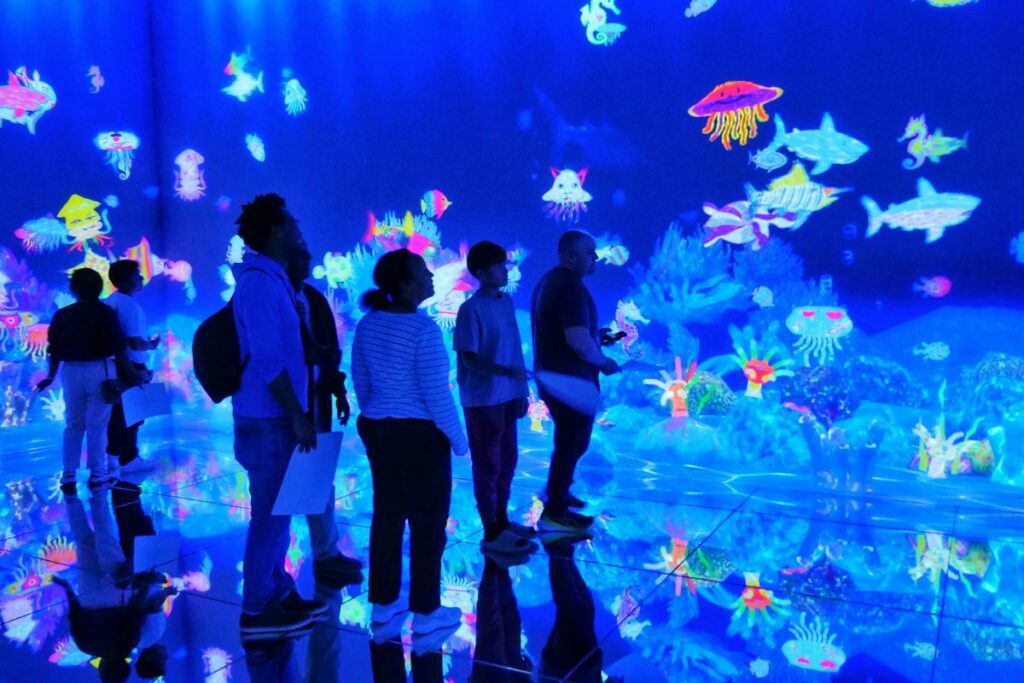
Food and Drink Options at TeamLab Borderless
While there are no restaurants or cafes inside TeamLab Borderless Tokyo, they do have the En Tea House.
If you are looking for rest after lots of wandering and exploring, the En Tea House is the perfect place to relax. Given that it’s inside Borderless, it is no regular tea house. The En Tea House often has a line, so you may have to queue to enter.
While you enjoy your cup of tea, digital flowers inside the cup bloom as you drink. The flowers also react to your touch and move whenever you lift the cup.
Various tea options are available, including cold brew green tea, barley tea, rice milk latte, and roasted green tea chamomile. These are all priced at 600 yen. They accept cashless payments only but have various methods including credit cards, IC cards, PayPay, and Line Pay.
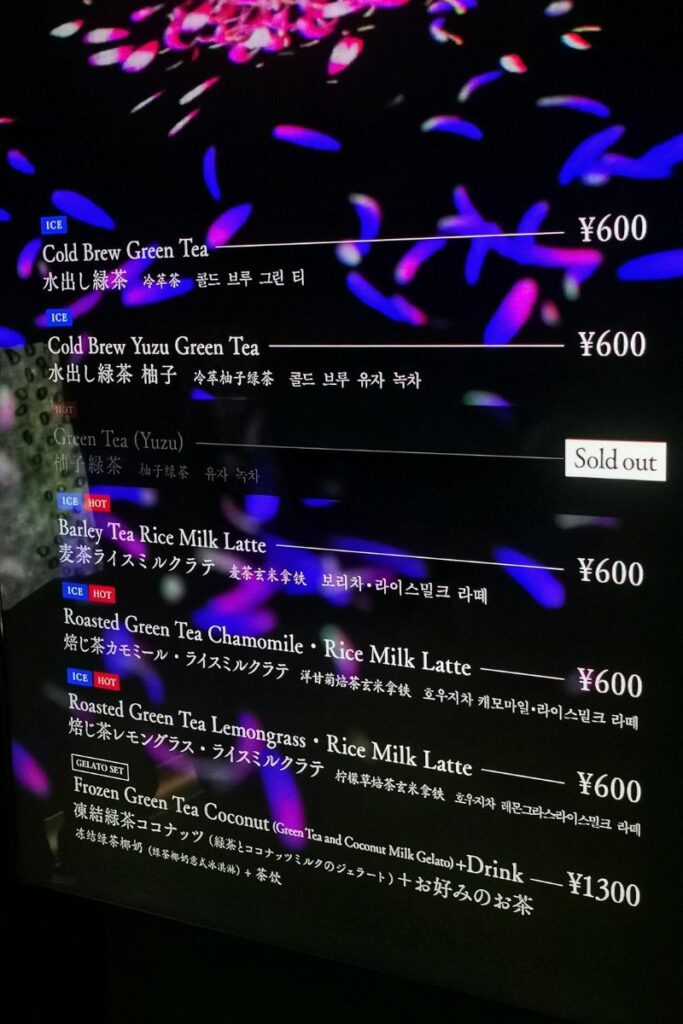
If you need to eat properly before or after you visit TeamLab Borderless Tokyo, Azabudai Hills has a wide selection of eateries.
- If you head to Azabudai Hills Market at B1F you could indulge in some wagyu beef at Hiyama Wagyu.
- There is a gyoza speciality shop called Kameidogyouza which sells a range of dumplings with different fillings.
- Sushi Saito is an upmarket sushi restaurant that only holds ten people and has a chef who treats sushi as works of art.
- If you would rather have something sweet, Mr Cheesecake sells a bunch of treats.
Tower Plaza is a short walk and has another large selection of restaurants and cafes.
- If you need something more familiar, they have a Starbucks on B1F.
- There is also a Shogun Burger here selling delicious Wagyu burgers.
- Head up to 3F to enjoy a steak at Ochiairo Steak House.
- If you are craving a pizza, why not check out Risto Pizza?
- If you head up to 34F you can enjoy stunning views of Tokyo Tower while having coffee and a cake at Hills House Sky Room Cafe.
Shopping and Souvenirs at TeamLab Borderless Tokyo
While TeamLab Borderless Tokyo doesn’t have a traditional gift shop, they do have the Sketch Factory.
Here you can take home your fish drawing from the Sketch Ocean but printed on a variety of products. These can be printed on items like tote bags, t-shirts, and towels. Plus you can change or even combine different drawings from their app before confirming your selection.
Sketch Factory Prices
- Tote bag: 3,000 yen
- Adult T-shirt: 4,000 yen
- Child T-shirt: 3,000 yen
- Hand towel: 1,500 yen
- Tin badge: 600 yen
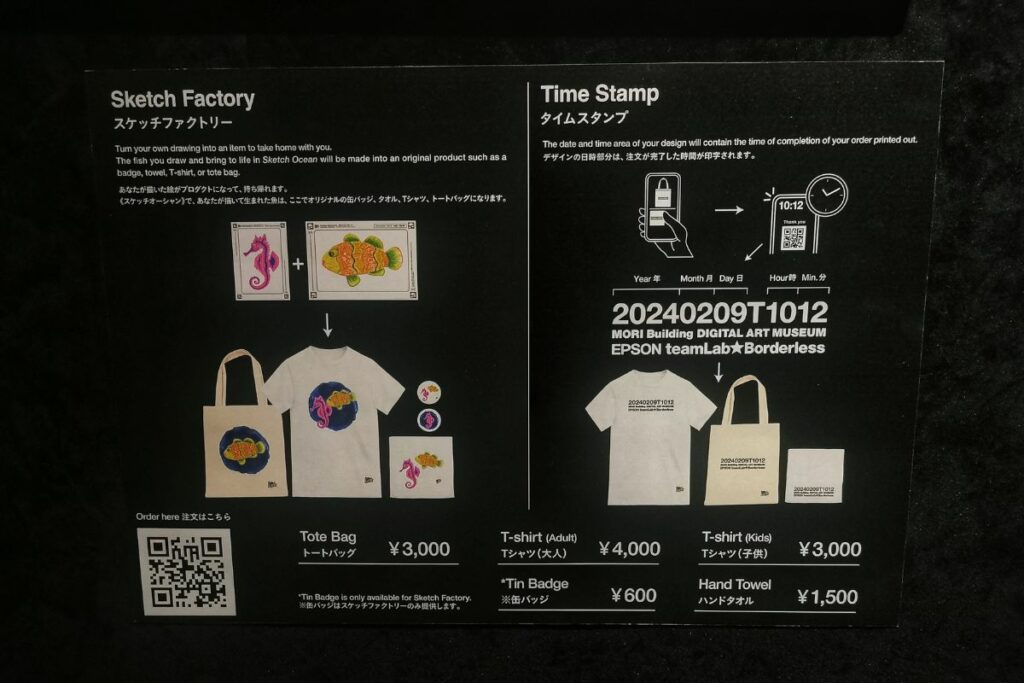
Tips and Tricks for a Great Experience at TeamLab Borderless
Now that I have been lucky enough to visit TeamLab Borderless Tokyo. I can offer some tips and tricks to help you make the most of your visit.
Book in Advance
Book in advance to avoid disappointment. Borderless can sell out up to a month in advance, so it’s best to pick a date ahead of schedule and book early.
Crowds
If you want to beat the crowds, avoid weekends and holidays. It’s usually quieter when it first opens or close to closing. Those are the timeslots I recommend if possible.
Clothing Requirements
There are no clothing requirements. And unlike TeamLab Planets, there is no physical water you have to walk through. You will be keeping your shoes on for the full duration. Wear comfortable shoes for walking or something stylish you want for your pictures.
Another tip is to avoid wearing clothing with too many patterns. Something white will make you stand out from the backgrounds, and black will offer a good contrast to the colourful backdrop designs.
Lockers
Before you enter the ticket gate there are free lockers to store your items. These don’t need coins. You must use these before entering the ticket gate as re-entry is not permitted, and these are the only lockers available. The lockers were big enough to store my backpack and jacket. This made my exploring more comfortable.
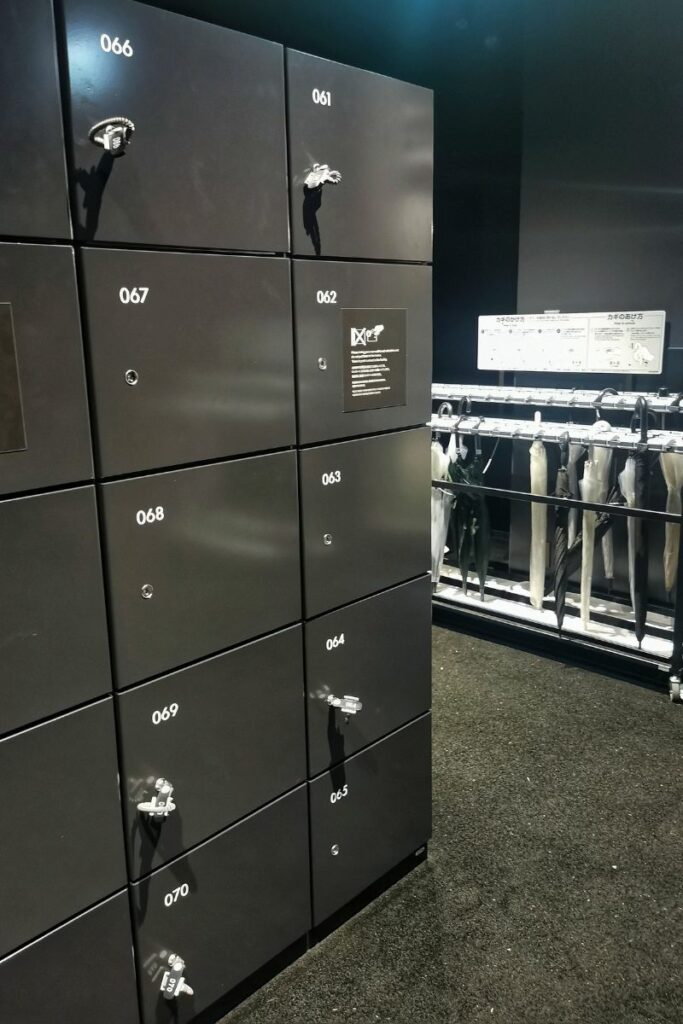
Photography
I found the best areas for photos were the Crystal World, the Bubble Universe, and the Universe of Water Particles on a Rock where People Gather.
These exhibits have the most space and the best lighting. This is ideal for getting creative with your pose while capturing a well-lit subject.
Restrooms
There are restrooms available inside TeamLab Borderless. One set is near the entrance, and the other is near the En Tea House. Both have diaper/nappy changing facilities.
Language Support
There is an information video that visitors watch while they are waiting to enter. The video has instructions in English, Japanese, Chinese, and Korean.
This is the same with any information screens before entering different exhibits or the tea house. I found it easy to navigate my way around inside using only English.
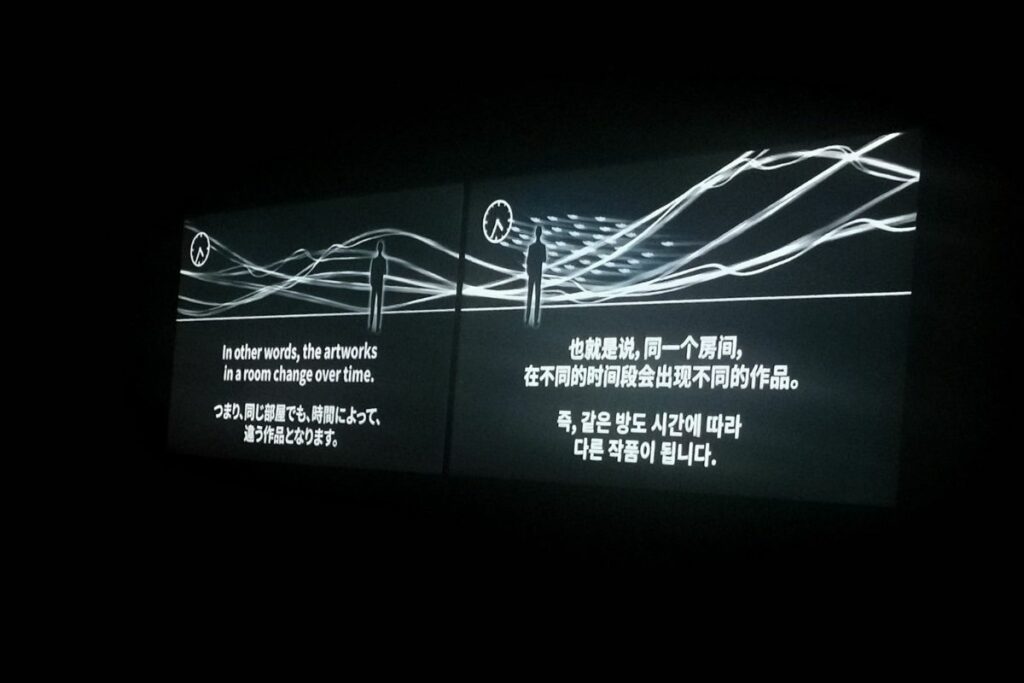
Accessibility
You are allowed to enter TeamLab Borderless with a wheelchair. Unfortunately, some of the exhibits are impossible to enter with a wheelchair. The website also states that you may be asked to wait, as the number of wheelchair users admitted at one time is limited.
Rest areas with seating and accessible toilets are also available at TeamLab Borderless Tokyo.
Nearby Attractions to TeamLab Borderless Tokyo
TeamLab Borderless Tokyo is located inside the Azabudai Hills Complex. The complex has many things to do, including a wide range of shops and restaurants.
For anime and manga fans, the Manga Art Heritage Gallery displays artwork from popular anime such as Bleach and One Piece.
The Azabudai Hills garden areas are also fun to walk around. Enjoy fresh air with greenery, interesting architecture, and modern art sculptures on display.
The Tokyo Tower is one of Tokyo’s best and most popular attractions and is a 10-minute walk from TeamLab Borderless. I was surprised at how close it was, and I had many great views of the iconic tower while exploring Azabudai Hills. Tokyo Tower would make a great attraction to pair with TeamLab Borderless, as you will enjoy the tower both in the day and at night.
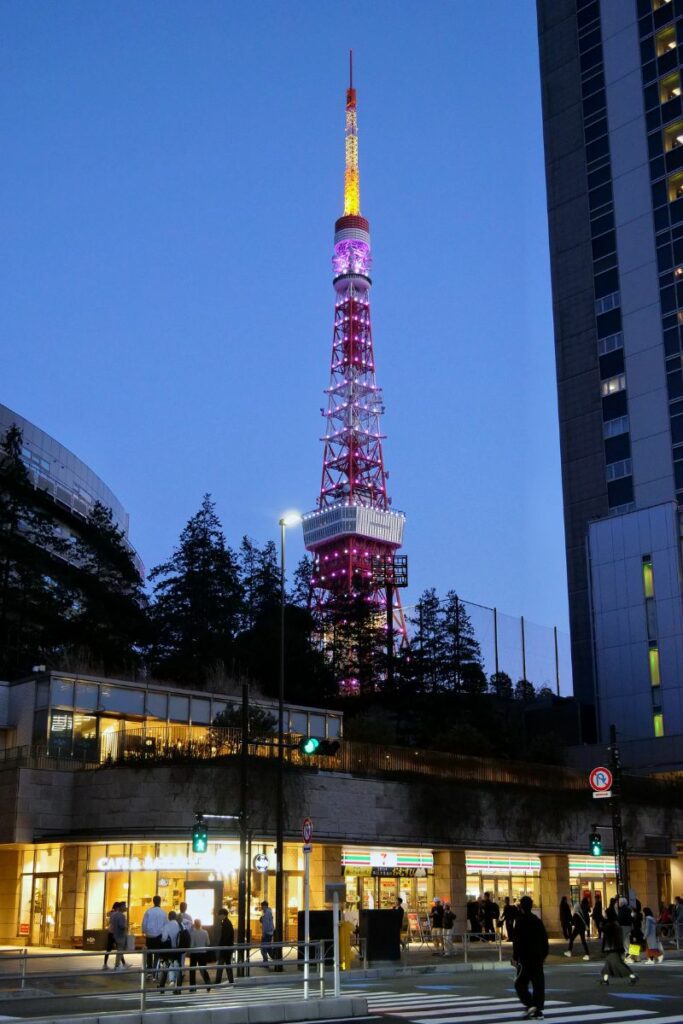
If you want something more relaxing and to escape the crowds, Mohri Garden is a 20-minute walk. This small park is in the middle of Roppongi, surrounded by skyscrapers. Here you can enjoy a pond, grassy areas, seasonal foliage and even a beer garden. And it is free entry.
TeamLab Borderless Review: Final Thoughts
I never had the chance to visit the original TeamLab Borderless in Odaiba. But I went to TeamLab Planets last year, so I did wonder “How different can this one actually be?”
Well, there are a few similarities, but I found TeamLab Borderless Tokyo to be a completely different experience.
TeamLab Borderless is a much larger space, and unlike TeamLab Planets, it doesn’t have a linear route to follow. This has both positive and negative aspects.
While it was fun wandering and exploring it on my own, I also found myself getting lost a few times. There were exhibits that I particularly enjoyed and wanted to see for a second time. But I often found myself getting lost and ending up back where I started.
TeamLab Planets is more hands-on, requiring you to walk through cushioned rooms or almost knee-deep water. TeamLab Borderless has no real water and is a flat space, which is more relaxing.
Both TeamLab venues offer something different. Depending on what type of experience you enjoy, you will know which one is right for you. I have read many complaints about TeamLab Planets smelling bad as the day goes on. While I didn’t experience this, you will be happy to hear that TeamLab Borderless smells wonderful, with many rooms offering different scents.
A misconception of TeamLab Borderless Tokyo is that it’s only an Instagram hotspot. While there are some great photo opportunities here, TeamLab Borderless offers much more than that.
It’s a very immersive experience and there are lots of details to admire. After snapping some photos, I put my camera away and explored and soaked it all in.
This is when TeamLab Borderless feels like a unique world to get lost in. This is what makes it worth the ticket price and worth your time.
Frequently Asked Questions about TeamLab Borderless Tokyo
If you have decided to visit TeamLab Borderless, you might still have some final worries or last-minute questions. I will do my best to answer some common questions.
- Discover the reborn TeamLab Borderless, now in Azubadai Hills. Guinness World Record Holder for the most visited museum (single art group).
- Explore a world of immersive digital art.
- Book through Klook or directly through Borderless.
- Also, check out the Klook Greater Tokyo Pass for discounts and more morning timeslots.
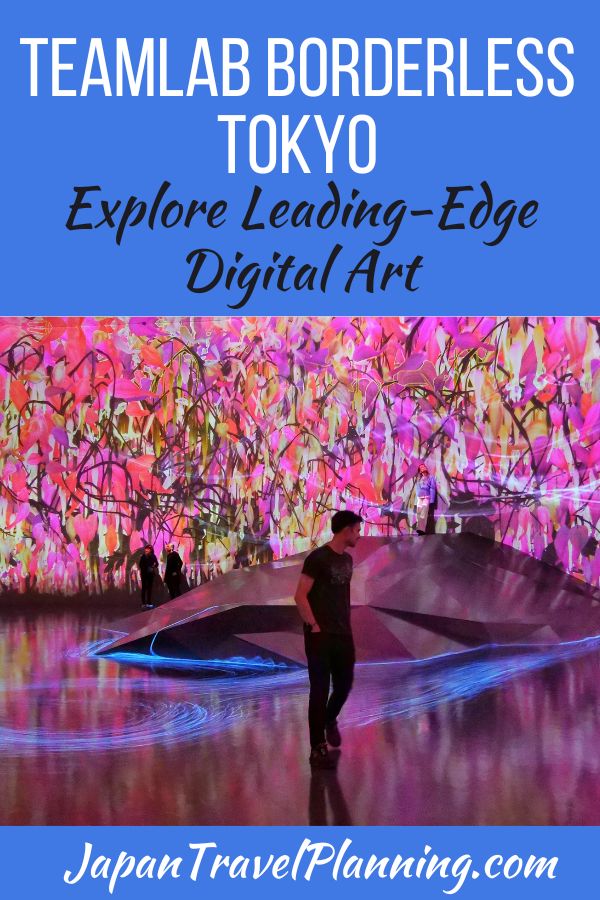
Join the Japan Travel Planning Facebook Group or Discord Server
You are also welcome to join our Japan Travel Planning Facebook Group and our Japan Travel Planning Discord Server – they are great resources to enable you to ask questions about your upcoming trip to Japan!
Disclaimer: This article contains affiliate links. If you book after clicking on one of these links then we may receive a small commission at no extra cost to you.

